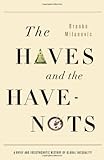Found in 2 comments on Hacker News
brudgers · 2011-03-22
· Original
thread
Although India is seeing economic growth, attaining US levels for income is a long way off. The top 5% of Indians by income have approximately the same level of purchasing power as the the lowest 5% of US residents on average according to World Bank economist Branko Milanovic in The Haves and the Have-Nots, a Brief and Idiosyncratic History of Global Inequality. [http://www.amazon.com/Haves-Have-Nots-Idiosyncratic-History-...]
That's not to say that there are not a large number of Indian individuals with substantial purchasing power (5% of Indians is 50 million people compared with 15 million in the US so there is a lot of disparity within the Indian group). Nevertheless, nearly everyone in the United States has more purchasing power than most of the top portion by income of the Indian population.
For Apple, it is a simple matter of economics - they will sell more iPads elsewhere and by creating scarcity they can sell older models at a high price to offset the lower profits Apple accepts when selling new products in wealthier countries.


I spent a few minutes googling hoping to find something academic by the same author, but didn't look as carefully as I should have.
But since you've called me out, I dug up my copy of the book. Apparently this paper is the original source and it uses 2005 data: https://www.gc.cuny.edu/CUNY_GC/media/CUNY-Graduate-Center/P...
No idea where to get the most current data.